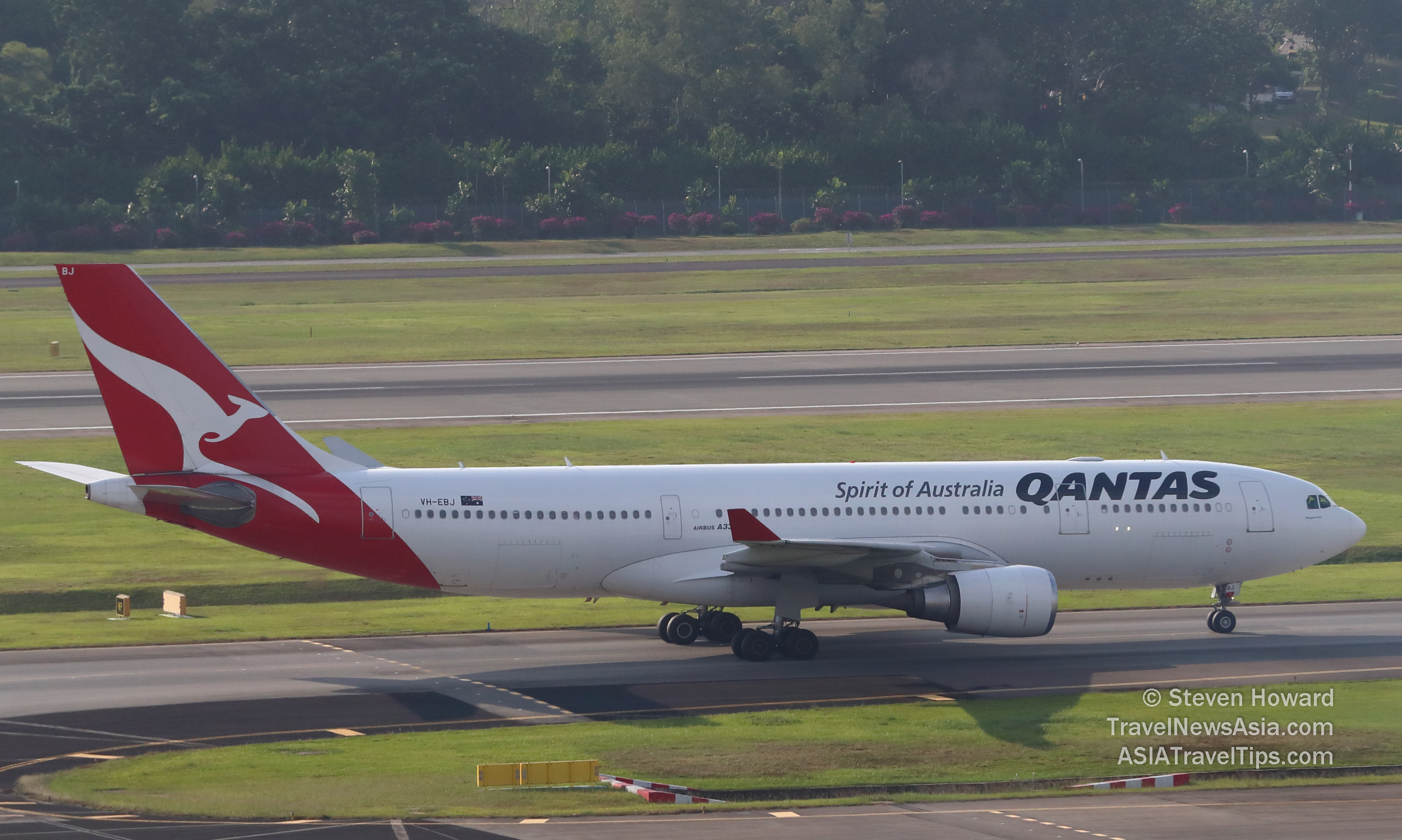|
The Qantas Group has put together a three-year
plan to accelerate its recovery from the ongoing COVID19 pandemic.
The plan includes reducing costs by $15 billion
during the three-year period, grounding around 100 aircraft for up
to 12 months or longer, reducing the number of employees and
extending stand downs, and raising up to $1.9 billion in equity to
accelerate recovery and position for new opportunities.
The plan will targets benefits of $15 billion over
three years, in line with reduced flying activity including fuel
consumption savings, and delivering $1 billion per annum in
ongoing cost savings from FY23 through productivity improvements
across the Group. Key details of the plan include:
- Reducing the group�s pre-crisis workforce by at
least 6,000 roles across all parts of the business.
- Continuing the stand down for 15,000 employees,
particularly those associated with international operations, until
flying returns.
- Retiring Qantas� six remaining 747s immediately,
six months ahead of schedule.
- Grounding up to 100 aircraft for up to 12 months
or longer, including most of the international fleet. The majority
are expected to ultimately go back in to service but some leased
aircraft may be returned as they fall due.
- Airbus A321neo and Boeing 787-9 fleet deliveries
have been deferred to meet the group�s requirements.
The cost of implementing the plan is estimated at
$1 billion, with most of this realised during FY21.

Qantas Group CEO Alan Joyce
said, �The Qantas Group entered this crisis in a better position
than most airlines and we have some of the best prospects for
recovery, especially in the domestic market, but it will take
years before international flying returns to what it was. We have
to position ourselves for several years where revenue will be much
lower. And that means becoming a smaller airline in the short
term. Most airlines will have to restructure in order to survive,
which also means they�ll come through this leaner and more
competitive. For all these reasons, we have to take action now.
�Adapting to this new reality means some very painful decisions.
The job losses we�re announcing today are confronting. So is the
fact thousands more of our people on stand down will face a long
interruption to their airline careers until this work returns.
What makes this even harder is that right before this crisis hit,
we were actively recruiting pilots, cabin crew and ground staff.
We�re now facing a sudden reversal of fortune that is no one�s
fault, but is very hard to accept. This crisis has left us no
choice but we�re committed to providing those affected with as
much support as we can. That includes preserving as many jobs as
possible through stand downs, offering voluntary rather than
compulsory redundancies where possible, and providing large
severance payouts for long serving employees in particular. As
we�ve done throughout this crisis, our decisions are based on the
facts we have now and the road we see in front of us. Our plan
gives us flexibility under a range of scenarios, including a
faster rebound or a slower recovery.�
Qantas will seek to
raise up to $1.9 billion, comprising of a fully underwritten
institutional placement to raise approximately $1,360 million and
a non-underwritten share purchase plan for eligible existing
shareholders to participate of up to $500 million.
Proceeds from the equity raising will be used to accelerate the
group�s recovery, strengthen its balance sheet and position it to capitalise on opportunities aligned with its strategy.
The
placement issue price of $3.65 per share represents a 12.9%
discount to the last traded price of $4.19 on 24 June 2020.
The approximately 372.7 million new fully paid ordinary shares
issued under the placement represents a 25% increase to total
shares on issue � which itself has decreased by more than a third
through share buybacks in recent years.
Employees
Of
the group�s 29,000 people, around 8,000 are expected to have
returned to work by the end of July this year. It�s anticipated
that this will increase to around 15,000 by the end of calendar
year 2020 in line with the opening up of domestic flying, and
increase further during calendar 2021 and 2022 as the
international network returns, reaching 21,000 active employees by
June 2022.
Redundancies are proposed to manage a surplus of
around 6,000 roles, with the temporary surplus of around 15,000
managed through a mix of stand down, annual leave and leave
without pay.
In line with its obligations,
Qantas will consult with relevant unions on the proposed job
losses announced today. These span the following areas of Qantas
and Jetstar:
- Non-Operational:
At least 1,450 job losses, mainly in corporate roles.
- Ground
Operations: At least 1,500 job losses across airports, baggage
handling, fleet presentation and ramp operations.
- Cabin Crew:
At least 1,050 job losses due to
early retirement of the 747s and less flying activity. A further
6,900 cabin crew will be on stand down from July 2020 onwards.
- Engineering:
At least 630 job losses due to 747 retirement, less
flying activity (particularly of the wide-body fleet) and
redistribution of work from Jetstar�s Newcastle base to make
better use of existing maintenance capacity in Melbourne.
- Pilots: At least 220 job losses mostly due to early retirement of
the 747s. A further 2,900 pilots will be on stand down from July
2020 onward.
Additional reduction in total roles will result
from contractors, particularly in corporate areas such as IT, not
returning.
Asset Impairments
While most of the
group�s long-haul aircraft are expected to steadily return to
service over time, there is significant uncertainty as to when
flying levels will support its 12 Airbus A380s. Those assets will
be idle for the foreseeable future, which represents a significant
percentage of their remaining useful life. As a result, the
carrying value of the A380 fleet, spare engines and spare parts
will be written down to their fair value, resulting in an
estimated non-cash impairment charge in the FY20 statutory result.
This represents the majority of the asset impairment charge of
$1.25� $1.4 billion, outlined in the table below. As a consequence
of the writedown, future depreciation expenses will reduce.
Fuel Hedging
The group�s fuel was fully hedged for the
second half of FY20, and 90% hedged for the first half of FY21.
With the significant decline in flying activity, the group�s
overall capacity flown has resulted in a substantial reduction in
fuel consumption from April 2020 and the anticipated decline in
consumption to June 2021 will lead to the non-cash recognition of
hedge ineffectiveness of $550�$600 million in the FY20 statutory
result.
FY20 Financial Performance
After reporting a
strong Underlying Profit Before Tax of $771 million in the first
half of FY20, the group saw a significant reduction in revenue
during the second half. By taking swift action to reduce its cash
burn as travel demand evaporated, the group expects to report a
full year result between breakeven and a small underlying profit
before tax.
Qantas Loyalty is expected to make the largest
positive contribution to this result, with only a 5%�10% reduction
in earnings compared to FY19 as a result of the impact of COVID19 on
travel related products and credit card spend. The program
continues to see strong levels of engagement, with a range of
initiatives planned over the next six months to maintain and
improve its value to members and partners.
Qantas Freight
performed strongly, driven by major increases in ecommerce that
are also expected to continue.
�Despite the hard choices we�re making today,
we�re fundamentally optimistic about the future. Almost two-thirds
of our pre-crisis earnings came from the domestic market, which is
likely to recover fastest � particularly as state borders prepare
to open. We have the leading full service and low fares airlines
in Australia, where distance makes air travel essential, and
diversified earnings through Qantas Loyalty. We still have big
ambitions for long haul international flights, which will have
even more potential on the other side of this. As a business,
recapitalising means we can get ready sooner for new
opportunities, returning to profit and building long term
shareholder value. As the national carrier, we remain committed to
supporting tourism, connecting regional communities and safely
flying millions of people every year,� Mr. Joyce said.
See also:
Australia Unlikely to Open Borders Until 2021.
See latest
Travel News,
Video
Interviews,
Podcasts
and other
news regarding:
COVID19,
Qantas,
Australia.
|
Headlines: |
|
|
